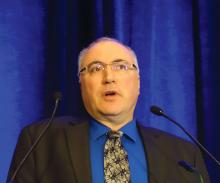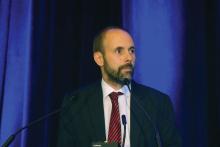Safety and tolerability for episodic migraine at 3-plus years
Among 383 episodic migraine patients who enrolled in an ongoing 5-year, open-label extension study of erenumab after completing a 12-week, placebo-controlled, double-blind clinical trial, there have been no new safety signals at a mean 3.2 years of follow-up. The incidence rates and types of adverse events remain indistinguishable from placebo as noted in the parent 12-week double-blind trial, with the exception of an increased rate of mild injection site reactions, reported Daniel D. Mikol, MD, PhD, executive medical director for global neuroscience development at Amgen in Thousand Oaks, Calif.
Erenumab proves effective in patients who have failed multiple preventive therapies
Jan Klatt, MD, presented the results of the 12-week, double-blind portion of the phase 3b LIBERTY study, the first clinical trial specifically designed to assess the effects of CGRP-directed therapy in patients who have previously failed to respond to and/or tolerate two to four currently available preventive medications at adequate doses for at least 2-3 months.
The rationale for the trial was straightforward: “There is a particularly high unmet need in patients who have failed currently available preventive therapies, and who are usually considered difficult to treat,” explained Dr. Klatt of Novartis in Basel, Switzerland.
LIBERTY included 246 such patients with episodic migraine who were randomized to 12 weeks of erenumab at 140 mg monthly or placebo. The primary endpoint – the proportion of patients with at least a 50% reduction in MMDs during weeks 9-12 from the baseline of 9.3 – occurred in 30.3% of the erenumab group, significantly better than the 13.7% rate with placebo, with an adjusted odds ratio of 2.73 for success with erenumab. An open-label extension study is ongoing.
A clear separation was already evident at week 4 of the randomized trial, a prespecified secondary endpoint. A 50% or greater reduction in MMDs was seen at that point in 23.5% of the erenumab group versus 4.8% in placebo-treated controls, for a response odds ratio of 6.16. A 75% or greater reduction in MMDs during weeks 9-12 occurred in 11.8% of the erenumab group and 4% of controls. A 100% response rate – that is, no migraines during weeks 9-12 – occurred in 5.9% of the active treatment arm and none of the controls. Outcomes on two novel patient-reported outcomes – the Migraine Physical Function Impact Diary–physical impairment and –everyday activities subscales – were also significantly better in the active treatment arm.
Treatment outcomes with erenumab were similar regardless of which drug classes patients had previously failed on, the three most common of which were beta-blockers, topiramate, and amitriptyline, which is approved for migraine prevention in Europe, where the LIBERTY trial was conducted.
One audience member observed that the 13.7% primary endpoint placebo response rate was far lower than typically seen in double-blind migraine trials.
“This is something we see quite consistently,” Dr. Klatt replied. “Once you proceed to this kind of more difficult-to-treat population, your placebo response rates drop to really low levels. It’s probably due to the fact that those patients have low expectations for any new therapy.”



